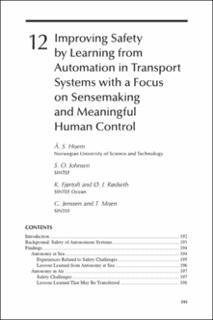| dc.description.abstract | Automated transport systems are deployed in many areas and transport modes. The predominant engineering perspective has been to automate as much as possible and minimize human interaction. However, a balanced integration between human factors and technology is often missing, as well as the “hand-over” process between humans and machine. The risks of automated and autonomous systems are emerging, and there is a need to explore how risks can be mitigated through design, focusing on sensemaking, meaningful human control and resilience engineering. This chapter presents key issues from an ongoing research project exploring safety, security and human control of autonomous transport systems in road, sea, rail and air. The chapter aims to answer: (1) What are the major safety and security challenges of autonomous industrial transport systems? (2) What can the various transport modes learn from each other? (3) What are suggested key measures related to organizational, technical and human issues? We have performed literature reviews, interviews and reviewed on-going automation projects. We see the importance of involving humans in the loop during design and operations, support sensemaking, focus on learning from projects through data gathering and risk-based regulation. Unanticipated deviations are key challenges in automated systems, together with how to design for human–automation interaction and meaningful user involvement. Limiting the operational envelope seems to be a key issue for successful implementation and operation of autonomous systems. | en_US |

